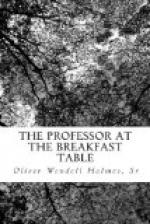are dying out; the red and white clovers, the broad,
flat leaves of the plantain,—“the
white man’s foot,” as the Indians called
it,—the wiry, jointed stems of that iron
creeping plant which we call “knot-grass,”
and which loves its life so dearly that it is next
to impossible to murder it with a hoe, as it clings
to the cracks of the pavement;—all these
plants, and many more, she wove into her fanciful
garlands and borders.—On one of the pages
were some musical notes. I touched them from
curiosity on a piano belonging to one of our boarders.
Strange! There are passages that I have heard
before, plaintive, full of some hidden meaning, as
if they were gasping for words to interpret them.
She must have heard the strains that have so excited
my curiosity, coming from my neighbor’s chamber.
The illuminated border she had traced round the page
that held these notes took the place of the words
they seemed to be aching for. Above, a long monotonous
sweep of waves, leaden-hued, anxious and jaded and
sullen, if you can imagine such an expression in water.
On one side an Alpine needle, as it were, of black
basalt, girdled with snow. On the other a threaded
waterfall. The red morning-tint that shone in
the drops had a strange look,—one would
say the cliff was bleeding;—perhaps she
did not mean it. Below, a stretch of sand, and
a solitary bird of prey, with his wings spread over
some unseen object.—And on the very next
page a procession wound along, after the fashion of
that on the title-page of Fuller’s “Holy
War,” in which I recognized without difficulty
every boarder at our table in all the glory of the
most resplendent caricature—three only
excepted,—the Little Gentleman, myself,
and one other.
I confess I did expect to see something that would
remind me of the girl’s little deformed neighbor,
if not portraits of him.—There is a left
arm again, though;—no,—that is
from the “Fighting Gladiator,” the “Jeune
Heros combattant” of the Louvre;—there
is the broad ring of the shield. From a cast,
doubtless. [The separate casts of the “Gladiator’s”
arm look immense; but in its place the limb looks light,
almost slender,—such is the perfection of
that miraculous marble. I never felt as if I
touched the life of the old Greeks until I looked on
that statue.]—Here is something very odd,
to be sure. An Eden of all the humped and crooked
creatures! What could have been in her head when
she worked out such a fantasy? She has contrived
to give them all beauty or dignity or melancholy grace.
A Bactrian camel lying under a palm. A dromedary
flashing up the sands,—spray of the dry
ocean sailed by the “ship of the desert.”
A herd of buffaloes, uncouth, shaggy-maned, heavy
in the forehand, light in the hind-quarter. [The buffalo
is the lion of the ruminants.] And there is a Norman
horse, with his huge, rough collar, echoing, as it
were, the natural form of the other beast. And
here are twisted serpents; and stately swans, with




